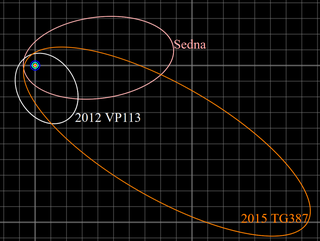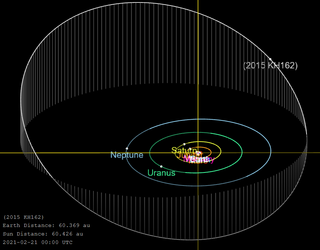
Sedna is a dwarf planet in the outermost reaches of the Solar System, orbiting the Sun beyond the orbit of Neptune. Discovered in 2003, the planetoid's surface is one of the reddest known among Solar System bodies. Spectroscopy has revealed Sedna's surface to be mostly a mixture of the solid ices of water, methane, and nitrogen, along with widespread deposits of reddish-colored tholins, a chemical makeup similar to those of some other trans-Neptunian objects. Within the range of uncertainties, it is tied with the dwarf planet Ceres in the asteroid belt as the largest dwarf planet not known to have a moon. Its diameter is roughly 1,000 km. Owing to its lack of known moons, the Keplerian laws of planetary motion cannot be employed for determining its mass, and the precise figure remains as yet unknown.

(612911) 2004 XR190, informally nicknamed Buffy, is a trans-Neptunian object, classified as both a scattered disc object and a detached object, located in the outermost region of the Solar System. It was first observed on 11 December 2004, by astronomers with the Canada–France Ecliptic Plane Survey at the Mauna Kea Observatories, Hawaii, United States. It is the largest known highly inclined (> 45°) object. With a perihelion of 51 AU, it belongs to a small and poorly understood group of very distant objects with moderate eccentricities.
1995 GJ might be a trans-Neptunian object and/or high-inclination cubewano from the Kuiper belt in the outermost region of the Solar System, and based on the calculated distance and brightness is assumed to be approximately 175 kilometers in diameter. It is a lost minor planet that has only been observed six times on the nights of 3–4 April 1995, by David Jewitt and Jun Chen at the Mauna Kea Observatory, Hawaii, using the UH88 telescope, and has not been observed ever since. The object is estimated to have been discovered right at perihelion at a distance of 39±1900 AU from the Sun. On the night of discovery, the object is estimated to have been moving away from Earth at 16 km/s with the uncertainty in the velocity being an unrealistic ±238000 km/s.

(308933) 2006 SQ372 is a trans-Neptunian object and highly eccentric centaur on a cometary-like orbit in the outer region of the Solar System, approximately 123 kilometers (76 miles) in diameter. It was discovered through the Sloan Digital Sky Survey by astronomers Andrew Becker, Andrew Puckett and Jeremy Kubica on images first taken on 27 September 2006 (with precovery images dated to 13 September 2005).

(523622) 2007 TG422 (provisional designation 2007 TG422) is a trans-Neptunian object on a highly eccentric orbit in the scattered disc region at the edge of Solar System. Approximately 260 kilometers (160 miles) in diameter, it was discovered on 3 October 2007 by astronomers Andrew Becker, Andrew Puckett and Jeremy Kubica during the Sloan Digital Sky Survey at Apache Point Observatory in New Mexico, United States. According to American astronomer Michael Brown, the bluish object is "possibly" a dwarf planet. It belongs to a group of objects studied in 2014, which led to the proposition of the hypothetical Planet Nine.

2010 GB174 is a detached object, discovered on 12 April 2010 on data taken at the Canada France Hawaii Telescope as part of the Next Generation Virgo Cluster Survey. It never gets closer than 48.5 AU from the Sun (about the outer edge of the Kuiper belt). Its large eccentricity strongly suggests that it was gravitationally scattered onto its current orbit. It is, like all detached objects, outside the current influence of Neptune, so how it got its current orbit is unknown. 2010 GB174 has the third highest Tisserand parameter relative to Jupiter of any Trans-Neptunian object, after Sedna and 2012 VP113. It has not been observed since 2015. It comes to opposition in late March each year in the constellation of Virgo.

(668643) 2012 DR30 is a trans-Neptunian object and centaur from the scattered disk and/or inner Oort cloud, located in the outermost region of the Solar System. The object with a highly eccentric orbit of 0.99 was first observed by astronomers with the Spacewatch program at Steward Observatory on 31 March 2009. It measures approximately 188 kilometers (120 miles) in diameter.
2005 VX3 is trans-Neptunian object and retrograde damocloid on a highly eccentric, cometary-like orbit. It was first observed on 1 November 2005, by astronomers with the Mount Lemmon Survey at the Mount Lemmon Observatory in Arizona, United States. The unusual object measures approximately 7 kilometers (4 miles) in diameter. It has the 3rd largest known heliocentric semi-major axis and aphelion. Additionally its perihelion lies within the orbit of Jupiter, which means it also has the largest orbital eccentricity of any known minor planet.

2012 VP113 is a trans-Neptunian object of the sednoid population, located in the outermost reaches of the Solar System. It was first observed on 5 November 2012 by American astronomers Scott Sheppard and Chad Trujillo at the Cerro Tololo Inter-American Observatory in Chile. The discovery was announced on 26 March 2014. The object probably measures somewhere between 300 and 1000 km in diameter, possibly large enough to be a dwarf planet.

A sednoid is a trans-Neptunian object with a large semi-major axis and a high perihelion, similar to the orbit of the dwarf planet Sedna. The consensus among astronomers is that there are only three objects that are known from this population: Sedna, 2012 VP113, and 541132 Leleākūhonua (2015 TG387). All three have perihelia greater than 60 AU. These objects lie outside an apparently nearly empty gap in the Solar System and have no significant interaction with the planets. They are usually grouped with the detached objects. Some astronomers consider the sednoids to be Inner Oort Cloud (IOC) objects, though the inner Oort cloud, or Hills cloud, was originally predicted to lie beyond 2,000 AU, beyond the aphelia of the three known sednoids.
2013 RF98 is a trans-Neptunian object. It was discovered on September 12, 2013, at Cerro Tololo-DECam.

(674118) 2015 KH162 is a large trans-Neptunian object orbiting in the scattered disc region of the outermost Solar System. First observed in 2015, this minor planet is one of the most distant objects from the Sun at 60.6 AU, or twice as far as Neptune.

(523794) 2015 RR245, provisional designation 2015 RR245, is a large trans-Neptunian object of the Kuiper belt in the outermost regions of the Solar System. It was discovered on 9 September 2015, by the Outer Solar System Origins Survey at Mauna Kea Observatories on the Big island of Hawaii, in the United States. The object is in a rare 2:9 resonance with Neptune and measures approximately 600 kilometers in diameter. 2015 RR245 was suspected to have a satellite according to a study announced by Noyelles et al. in a European Planetary Science Congress meeting in 2019.

2014 FE72 is a trans-Neptunian object first observed on 26 March 2014, at Cerro Tololo Inter-American Observatory in La Serena, Chile. It is a possible dwarf planet, a member of the scattered disc, whose orbit extends into the inner Oort cloud. Discovered by Scott Sheppard and Chad Trujillo, the object's existence was revealed on 29 August 2016. Both the orbital period and aphelion distance of this object are well constrained. 2014 FE72 had the largest barycentric aphelion until 2018. However, the heliocentric aphelion of 2014 FE72 is second among trans-Neptunian objects (after the damocloid 2017 MB7). As of 2023, it is about 66 AU (9.9 billion km) from the Sun.
2017 MB7 is a trans-Neptunian object and damocloid on a cometary-like orbit from the outer Solar System, approximately 6 kilometers (4 miles) in diameter. It was first observed on 22 June 2017 by the Pan-STARRS survey at Haleakala Observatory in Hawaii, United States. This unusual object has the largest heliocentric aphelion, semi-major axis, orbital eccentricity and orbital period of any known periodic minor planet, even larger than that of 2010 LN135 and 2014 FE72; it is calculated to reach several thousand AU (Earth-Sun) distances at the farthest extent of its orbit.

541132 Leleākūhonua (provisional designation 2015 TG387) is an extreme trans-Neptunian object and sednoid in the outermost part of the Solar System. It was first observed on 13 October 2015, by astronomers at the Mauna Kea Observatories, Hawaii. Based on its discovery date near Halloween and the letters in its provisional designation 2015 TG387, the object was informally nicknamed "The Goblin" by its discoverers and later named Leleākūhonua, comparing its orbit to the flight of the Pacific golden plover. It was the third sednoid discovered, after Sedna and 2012 VP113, and measures around 220 kilometers (140 miles) in diameter.

2018 VG18 is a distant trans-Neptunian object (TNO) that was discovered when it was 123 AU (18 billion km; 11 billion mi) from the Sun, more than three times the average distance between the Sun and Pluto. It was discovered on 10 November 2018 by Scott Sheppard, David Tholen, and Chad Trujillo during their search for TNOs whose orbits might be gravitationally influenced by the hypothetical Planet Nine. They announced the discovery of 2018 VG18 on 17 December 2018 and nicknamed the object "Farout" to emphasize its distance from the Sun.

2018 AG37 is a distant trans-Neptunian object and centaur that was discovered 132.2 ± 1.5 AU (19.78 ± 0.22 billion km) from the Sun, farther than any other currently observable known object in the Solar System. Imaged in January 2018 during a search for the hypothetical Planet Nine, the confirmation of this object was announced in a press release in February 2021 by astronomers Scott Sheppard, David Tholen, and Chad Trujillo. The object was nicknamed "FarFarOut" to emphasize its distance from the Sun.



















